摘要: 铋黄铜具有很好的机械加工性能且更为环保, 具有广泛的应用. 本文采用高重复频率激光剥离-火花诱导击穿光谱技术来实现铋黄铜中微量元素的快速和高灵敏分析. 实验采用小型化光纤激光器作为剥离光源, 采用小型化光纤光谱仪采集光谱, 对铋黄铜中的铋、铅和锡三元素开展了定量分析. 实验确定等离子体的温度和电子密度分别为7962 ± 300 K 和1.049 × 10
–17 cm
–3 . 在该条件下建立了铋、铅和锡三元素的校正曲线, 并得到了较好的拟合优度. 现有条件下三元素的检测限分别达到了25.5 × 10
–6 , 64.2 × 10
–6 和316.5 × 10
–6 . 其中锡的检出限较高, 与锡的原子谱线强度较弱有关. 结果表明, 采用小型化的高重复频率激光剥离-火花诱导击穿光谱仪可以实现对铋黄铜中微量元素的便捷和高灵敏分析.
关键词: 激光剥离 /
火花诱导击穿光谱 /
铋黄铜 /
元素分析 /
小型化 English Abstract Quantitative analysis of trace elements in bismuth brass with high repetition rate laser-ablation spark-induced breakdown spectrum Huang Mei-Ting Jiang Yin-Hua Chen Yu-Qi Li Run-Hua School of Physics and Optoelectronics, South China University of Technology, Guangzhou 510641, China Fund Project: Project supported by the National Natural Science Foundation of China (Grant No. 61875055)Received Date: 30 November 2020Accepted Date: 23 December 2020Available Online: 13 May 2021Published Online: 20 May 2021Abstract: Bismuth brass has very good mechanical properties and is friendly to environment. Therefore, it can be widely used in different fields. In order to realize the convenient, rapid and sensitive elemental analysis of trace elements in bismuth brass, fiber laser based high repetition rate laser-ablation spark-induced breakdown spectroscopy (HRR LA-SIBS) is developed. In the experiments, a compact fiber laser operated at 5 kHz pulse repetition rate is used to ablate the sample and produce plasma, and the spark discharge is used to further break down the ablated sample and enhance the plasma emission for sensitive elemental analysis. A compact fiber-optic spectrometer coupled with non-intensified charge-coupled device (CCD) is used to record the spectra. Bismuth, lead and tin in several bismuth brass standard samples are quantitatively analyzed. The plasma temperature is determined to be about 7962 ± 300 K by using the Boltzmann plots of copper, zinc and tin elements; the electron density is determined to be about 1.049 × 10–17 cm–3 based on the Stark broadening of Cu (I) 510.47 nm analytical line. The plasma is determined to be in local thermodynamic equilibrium (LTE) state according to McWhirter criterion as well as appended criteria for transient plasma. Under the present experimental condition, the calibration curves of bismuth, lead and tin in bismuth brass are built with fitting goodness of higher than 95%. The detection limits of bismuth, lead and tin are determined to be 25.5 ppm, 64.2 ppm and 316.5 ppm, respectively. The weak transition probability of tin atoms leads to worse detection limit of tin than the scenarios of bismuth and lead. The ways to further improve the analytical sensitivity and minimize system dimensions are discussed in this article. It is demonstrated that high repetition rate laser-ablation spark-induced breakdown spectrometer based on compact fiber laser as well as compact fiber-optic spectrometer can be used to realize the convenient, rapid and sensitive elemental analysis of trace elements in bismuth brass. This study is also helpful in analyzing the trace harmful elements, including bismuth, lead and tin in high temperature alloys with HRR LA-SIBS. In comparison with laser-induced breakdown spectroscopy (LIBS), the HRR LA-SIBS technique has several intrinsic advantages, such as fast spectral data collection speed, cost-effective system and low continuum background and so on. This technique is very useful in implementing the elemental analysis of different alloy samples and can be potentially used in metallurgical industry in the future.Keywords: laser-ablation /spark-induced breakdown spectroscopy /bismuth brass /elemental analysis /compact 全文HTML --> --> --> 1.引 言 铅黄铜具有优良的切削性能和机械性能, 因而在电子产品、精密仪器仪表、水暖卫浴等领域获得了广泛的应用. 但是由于铅属于有害重金属元素, 对人体健康会造成潜在的威胁, 为此国际上对不同产品中铅的含量都制定了相应的限制标准. 为了减少铅的危害, 人们研究采用对人体无害的铋元素代替铅元素开发出了铋黄铜, 同时添加其他微量元素, 比如锡、锑等来改善其物理性能[1 ] . 为了研制性能优良的铋黄铜, 对其中的微量元素开展快速的定量分析非常必要.[2 ] . 探索合金中的铋、铅和锡等元素的高灵敏快速分析技术, 对于提高特种合金的质量也有重要的意义.[3 -7 ] . 为了提高LIBS的光谱分析灵敏度, 人们还研究了双脉冲激发[8 ] 以及与激光诱导荧光光谱联用的技术[9 -11 ] , 这两种技术需要多套激光系统, 不便于实现实验室以外移动的便携式的元素分析. 寻找和建立快捷便利、仪器小型化且光谱分析灵敏度高的等离子体光谱元素分析技术, 对冶金行业有着重要的应用价值.[12 -14 ] . 该技术采用小型的高重复频率脉冲激光作为样品的剥离光源, 采用火花放电来进一步击穿被剥离的样品和增强等离子体辐射, 从而可以获得较高的光谱分析灵敏度. 由于采用了小型化的激光器和光谱仪, 火花放电单元的电功率也不高, 体积可以很小, 这些有利于将来搭建便携式、小型化的光谱分析系统, 使合金样品的元素分析变得快捷和方便.2.实 验 本研究所采用的HRR LA-SIBS的实验装置如图1 所示. 实验装置主要由激光剥离、火花放电和光谱记录三部分组成. 采用一台MOPA (main oscillator + power amplifier) 型的光纤激光器(深圳市创鑫激光股份有限公司, 型号: MFPT-70P)作为剥离激光光源. 该激光器的主机大小为35 cm×26 cm × 12 cm, 输出激光的中心波长为1064 nm, 最大输出单脉冲能量为1.0 mJ, 脉宽在50—350 ns范围内可调, 激光脉冲的重复频率在1—1000 kHz范围内可调, 光束的品质因子M 2 为1.2. 实验中选择脉冲重复频率为5 kHz, 脉冲宽度为100 ns. 激光束经过一个焦距f = 60 mm的球透镜L1 垂直聚焦于样品表面剥离样品并产生激光等离子体, 采用火花放电进一步击穿被剥离的样品并增强等离子体的光学辐射.图 1 基于光纤激光器的HRR LA-SIBS的实验装置示意图Figure1. Schematic diagram of the experimental setup of fiber laser based HRR LA-SIBS.R 1 给一个高压电容C 充电. 其中R 1 = 16.7 kΩ, C = 5 nF. 在放电回路中串联了一个阻值R 2 = 2 Ω的电阻. 采用一根直径为1.6 mm的钨针作为火花放电的阳极, 样品本身作为火花放电的阴极. 钨针与激光成45°夹角放置, 钨针的针尖与样品表面的垂直距离以及与激光传输中轴的水平距离均为0.5 mm. 样品被安装在一个二维运动平台上, 实验中平台的运动速度为3 mm/s. 实验前用500号的砂纸对样品表面进行抛光处理达到优于Ra0.3的表面光洁度, 以确保激光剥离和火花放电的稳定性. 实验观测到火花放电与激光等离子体的形成在时间上几乎同步, 且火花放电是严格的脉冲放电, 即一个激光脉冲诱发一次火花放电.2 收集和准直、再由一个焦距为150 mm的石英透镜L3 汇聚至一台小型的光纤光谱仪(Avantes, 型号: AvaSpec- ULS2048-3-USB2)的光纤入口. 该光谱仪配置的探测器为普通型的CCD (charge coupled device)探测器. 光谱仪的主机大小为32 cm × 24 cm × 14 cm, 波长范围为200—550 nm, 光谱分辨率优于0.15 nm. 光谱仪的光谱响应已采用标准灯 (Avantes, 型号: AvaI light-DHBAL-CAL) 进行过校准. 由于激光的脉冲重复频率较高, 记录光谱时没有采用任何脉冲同步和进行门宽设置. 光谱仪工作在连续采样的模式, 其积分时间和平均次数由光谱数据采集软件来设置.表1 列出了该标准样品中铋、铅和锡元素的质量百分比的浓度. 该浓度值采用ICP-OES测定, 其不确定度均小于2%.Sample No. Bi Pb Sn 1 3.002 0.0054 1.038 2 0.414 0.105 0.306 3 1.561 0.0161 0.518 4 0.826 0.0209 2.007 5 0.108 0.0059 3.020 6 0.0058 — —
表1 标准样品中铋、铅和锡元素的质量分数Table1. List of the mass fraction (%) of bismuth, lead and tin in standard samples.3.结果与讨论 23.1.光谱观测 3.1.光谱观测 图2 所示为实验记录得到的铋黄铜在240—340 nm波长范围内的局部光谱图. 该光谱已经对光谱仪的响应函数进行了校准. 记录图2 中的光谱采用的CCD的积分时间为10 ms, 实验时重复记录200次并进行数学平均, 最后得到平均后的等离子体发射光谱. 图中铜的两根强线324.75 和 327.40 nm 平顶是由于探测器饱和造成的. 由于图2 已对仪器的光谱响应函数进行了校准, 虽然紫外区的信号看似强于可见区, 但实际上比较弱, 因而没有出现饱和现象.图 2 校准后的2号样品的局部光谱图Figure2. The calibrated partial spectrum of sample No. 2.3.2.等离子体特征参数的确定 -->3.2.等离子体特征参数的确定 假设等离子体处于局部热力学平衡(local thermodynamic equilibrium, LTE)状态下, 且等离子体是光学薄的, 电子在两个能级之间跃迁所对应的光谱线强度可以表示为[15 ] $\lambda $ 是原子从${E_k}$ 能级跃迁到${E_i}$ 能级所发射的光子的波长; $I_\lambda ^{ki}$ 是线积分强度值; ${C_{\rm{s}}}$ 是跃迁粒子浓度; ${A_{ki}}$ 是跃迁几率; $g$ 是能级简并度; $F$ 是一个与仪器系统有关的常数; ${k_{\rm{B}}}$ 是Boltzmann常数; $T$ 是等离子体温度; ${U_{\rm{s}}}(T)$ 是配分函数.1 )式等号两边取对数, 并令1 )式可改写为$T$ . 表2 列出了选取的铜、锌和锡元素的分析线和相关的能级以及跃迁几率等参数. 其中${g_k}$ , ${A_{ki}}$ 和${E_k}$ 的值是从NIST原子光谱数据库中获取的.Species $\lambda $/nm A/s–1 gk Ek /eVCu Ⅰ 261.83 3.07 × 107 4 6.120 Cu Ⅰ 282.43 0.78 × 107 6 5.780 Cu Ⅰ 306.34 1.55 × 106 4 5.688 Cu Ⅰ 319.40 1.55 × 106 4 5.523 Cu Ⅰ 333.78 0.38 × 106 8 5.102 Cu Ⅰ 406.26 2.10 × 107 6 6.868 Cu Ⅰ 510.55 0.20 × 107 4 3.820 Cu Ⅰ 515.32 0.60 × 108 4 6.190 Zn Ⅰ 307.58 0.38 × 106 3 4.030 Zn Ⅰ 328.23 9.00 × 107 3 7.780 Zn Ⅰ 330.25 1.20 × 108 5 7.783 Zn Ⅰ 334.50 1.70 × 108 7 7.783 Sn Ⅰ 242.94 1.50 × 108 7 5.527 Sn Ⅰ 270.65 6.60 × 107 5 4.789 Sn Ⅰ 283.99 1.70 × 108 5 4.789 Sn Ⅰ 286.33 5.40 × 107 3 4.329 Sn Ⅰ 300.91 3.80 × 107 3 4.329 Sn Ⅰ 303.41 2.00 × 108 1 4.295 Sn Ⅰ 317.50 1.00 × 108 3 4.329 Sn Ⅰ 326.23 2.70 × 108 3 4.867
表2 计算等离子体温度所选择的谱线及相应能级与跃迁参数列表Table2. List of the energy level and transition probability of the selected lines for plasma temperature calculation.图3 为得到的玻尔兹曼图. 分别对三种元素的数据点做线性拟合得到三条直线, 三条直线近似平行, 表明等离子体近似处于LTE的状态. 根据由铜、锌、锡三元素分别确定的等离子体温度, 最后得到等离子体的平均温度为7962 ± 300 K.图 3 用于测定等离子体温度的玻尔兹曼图Figure3. Boltzmann plots used to estimate the plasma temperature.${N_{\rm{e}}}$ 必须满足McWhirter准则, 也就是$\Delta E$ 为光谱发射上下能级之间的最大能量差, T 是求得的等离子体温度. 忽略其他谱线增宽的因素, 认为谱线展宽主要是由于Stark展宽引起的, 则可以由谱线的展宽计算出电子密度${N_{\rm{e}}}$ , 即$N_{\rm{e}}^{{\rm{ref}}}$ 为电子密度的参考值, 为1.0 × 1016 cm–3 ; $\omega $ 为Stark展宽参数. 此处选取Cu I510.47 nm 的谱线来计算电子密度. 对应该谱线的$\omega $ 值可以由文献得到[16 ,17 ] , 温度为5000 K左右时的$\omega $ 值为1.02 nm; 谱线展宽可近似由$\Delta {\lambda _{1/2}}=\Delta {\lambda _{{\rm{observed}}}} - $ $ \Delta {\lambda _{{\rm{instrument}}}}$ 计算得出. 这里的$\Delta {\lambda _{{\rm{observed}}}}$ 是拟合实测的谱线得到的谱线的展宽(半高全宽FWHM)值; $\Delta {\lambda _{{\rm{instrument}}}}$ 是光谱仪的仪器展宽, 通过测量低压汞灯的发射谱线确定该值为0.11 nm. 图4 给出了采用洛伦兹函数拟合Cu I 510.47 nm谱线的结果. 根据得到的实测谱线宽度和仪器展宽, 最后确定等离子体的电子密度为1.05 × 1017 cm–3 . 该电子密度满足(5 )式的McWhirter准则.图 4 Cu I 510.47 nm谱线的洛伦兹拟合图Figure4. Lorentzian fit of Cu I line.[18 ] 提出了两个附加的判定原则来确定瞬态等离子体是否处于LTE状态, 第一个判定原则是, 处于LTE状态下的等离子体的热力学弛豫时间${\tau _{{\rm{rel}}}}$ 要远远小于扩张时间${\tau _{\exp }}$ , 等离子体的扩张时间${\tau _{\exp }}$ 通过计算约等于${\rm{1}}{{\rm{0}}^{{\rm{ - 6}}}}\;{\rm{s}}$ ; 第二个判定原则是, 处于LTE状态下的等离子体的尺寸至少是元素扩散长度$\lambda $ 的10倍, 而等离子体的直径长度通常约1.5—2 mm. 计算${\tau _{{\rm{rel}}}}$ 和$\lambda $ 的表达式为[18 ] ${f_{ik}}$ 是能级跃迁的吸收振子强度, 可以从NIST数据库中获取, $\langle \bar g \rangle$ 是一个有效的Gaunt因子, 可以从文献中获取[19 ] , $\Delta {E_{ik}}$ 是能量差, ${M_{\rm{A}}}$ 是元素的相对原子质量.10 )式和(11 ) 式计算得到等离子体的弛豫时间在1.99—3.72 ns范围内, 远远小于扩张时间${\tau _{\exp }}$ (${\rm{1}}{{\rm{0}}^{{\rm{ - 6}}}}$ s); 元素扩散长度$\lambda $ 在0.079—0.109 mm范围内, 小于等离子体尺寸1.5—2 mm的1/10. 综上, 样品产生的等离子体满足McWhirter 准则的同时也满足Cristoforetti等[18 ] 提出的两个附加判定原则, 因此可以认为本研究中产生的等离子体满足LTE的条件.3.3.校正曲线和检出限 -->3.3.校正曲线和检出限 为了开展元素的定量分析, 分别选择了Bi I 306.77 nm, Pb I 405.78 nm 和Sn I 326.23 nm的三条元素分析线来制定校正曲线. 图5 给出了2号样品得到的包含上述分析线的局部光谱. 为了减小实验条件的微小变化对信号强度的影响, 选择Cu I 510.47 nm的谱线作为内标线, 采用与此谱线强度的相对强度值来制定校正曲线. 其中所有谱线强度值均为扣除了微弱背景后得到的谱峰的净信号强度.图 5 校准后的2号样品的局部光谱图Figure5. The calibrated partial spectrum of sample No.2.图6(a) 为得到的铋元素的校正曲线. 图中误差棒表示相同实验条件下多次重复测量的结果的偏差大小. 浓度越高, 偏差的绝对值也越大, 其相对标准偏差大约为8%. 由于Bi I 306.77 nm为共振线, 存在较明显的自吸收效应, 该校正曲线是非线性的, 因此可以采用Aragon等[20 ] 提出的一个非线性函数来加以拟合. 表达式为图 6 用HRR LA-SIBS分析铋黄铜中铋、铅和锡的校正曲线 (a) Bi; (b) Pb; (c) SnFigure6. Calibration curves of bismuth, lead and tin in bismuth brass analyzed with HRR LA-SIBS: (a) Bi; (b) Pb; (c) Sn.${I_{{\rm{obs}}}}$ 为信号强度; a 是一个直流背景, 由于此处已经扣除过背景, 因此a = 0; ${C_{{\rm{ele}}}}$ 表示元素浓度, b 是低浓度时的校正曲线的斜率; c 是表征饱和效应发生程度的元素浓度参数. 当元素浓度很低时, (9 )式可简化为[21 ] 图6(b) 和图6(c) 分别给出了铋黄铜中铅和锡的校正曲线. 它们可以用经过原点的直线进行线性拟合. 由于在1号和5号标准样品中铅元素的浓度较低, 铅的信号较弱, 因此铅的校正曲线中只包含了三个数据点. 三种元素的校正曲线的拟合结果较好, 其拟合优度${R^2}$ 的值均大于0.95.σ 规则进行评估, 也就是当信号强度等于背景标准偏差的3倍时所对应的元素浓度即为该元素的检出限(limit of detection, LOD). 即${\sigma _{\rm{B}}}$ 是指分析空白样品时在分析线波长处的背景的标准偏差, S 是线性校正曲线的斜率. 对于采用考虑自吸收饱和效应后的非线性方程(9 )拟合的校正曲线, S 的取值为(9 )式中的参数b . 由于较难获得严格意义上的空白样品, 本文中的背景标准偏差是由在分析线附近没有任何原子辐射线干扰的一小段波长范围内的背景的标准偏差来近似替代的. 由于纵轴采用了相对于Cu I 510.47 nm的谱线的相对强度, 因此用于计算LOD的背景标准偏差也需要除以Cu I 510.47 nm的谱线强度. 表3 列出了铋、铅和锡三种元素的分析线波长和相关分析结果. 结果显示, 采用HRR LA-SIBS技术, 在当前实验条件下得到的这三种元素的检出限分别为25.5 × 10–6 , 64.2 × 10–6 和316.5 × 10–6 . 其中锡的检出限相对较差, 与锡的原子谱线强度较弱有关.Analytical line S σ B R2 LOD /10–6 Bi Ⅰ 306.77 nm 1.818 0.00155 0.98 25.5 Pb Ⅰ 405.78 nm 1.376 0.0029 0.98 64.2 Sn Ⅰ 326.23 nm 0.210 0.0022 0.96 316.5
表3 铋黄铜中铋、铅、锡三元素的HRR LA-SIBS分析结果Table3. Analytical results of bismuth, lead and tin in bismuth brass with HRR LA-SIBS.4.结 论 本文首次采用高重复频率激光剥离-火花诱导击穿光谱(HRR LA-SIBS)技术开展了铋黄铜中微量的铋、铅、锡三元素的定量分析研究. 对这三种元素开展定量分析, 不仅有助于提高铋黄铜的质量, 还为开展镍基高温合金中铋、铅、锡等有害元素的定量分析提供了技术参考. 本研究采用玻尔兹曼图测得了等离子体的温度, 通过铜原子谱线的增宽确定了等离子体的电子密度, 并证明现有实验条件下得到的等离子体是处于LTE状态的. 选择Bi I 306.77 nm, Pb I 405.78 nm 和Sn I 326.23 nm作为分析线, 采用内标法制定了铋黄铜中铋、铅和锡三元素的校正曲线. 现有实验条件下得到的铋黄铜中铋、铅和锡三元素的检出限分别为25.5 × 10–6 , 64.2 × 10–6 和 316.5 × 10–6 . 本研究表明, 采用高重复频率激光剥离-火花诱导击穿光谱可以对铋黄铜中的微量元素开展快捷、便利和高灵敏的定量分析. 与传统的ICP-OES技术相比, 该技术不仅无需消解样品, 提高了分析速度, 还有望实现仪器的小型化和移动式光谱分析, 在冶金行业获得广泛的应用. 采用配备ICCD探测器的中阶梯光谱仪替代本文中的光纤光谱仪, 可进一步改善元素的检出限. 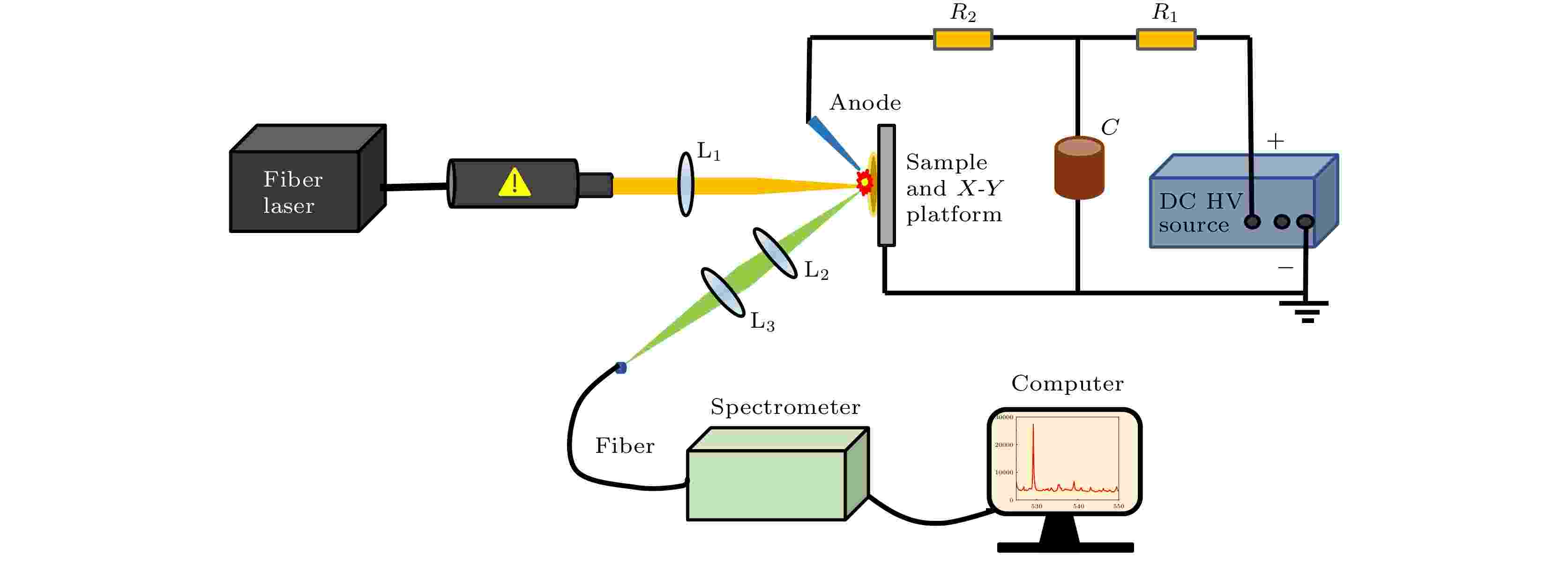 图 1 基于光纤激光器的HRR LA-SIBS的实验装置示意图
图 1 基于光纤激光器的HRR LA-SIBS的实验装置示意图 图 2 校准后的2号样品的局部光谱图
图 2 校准后的2号样品的局部光谱图














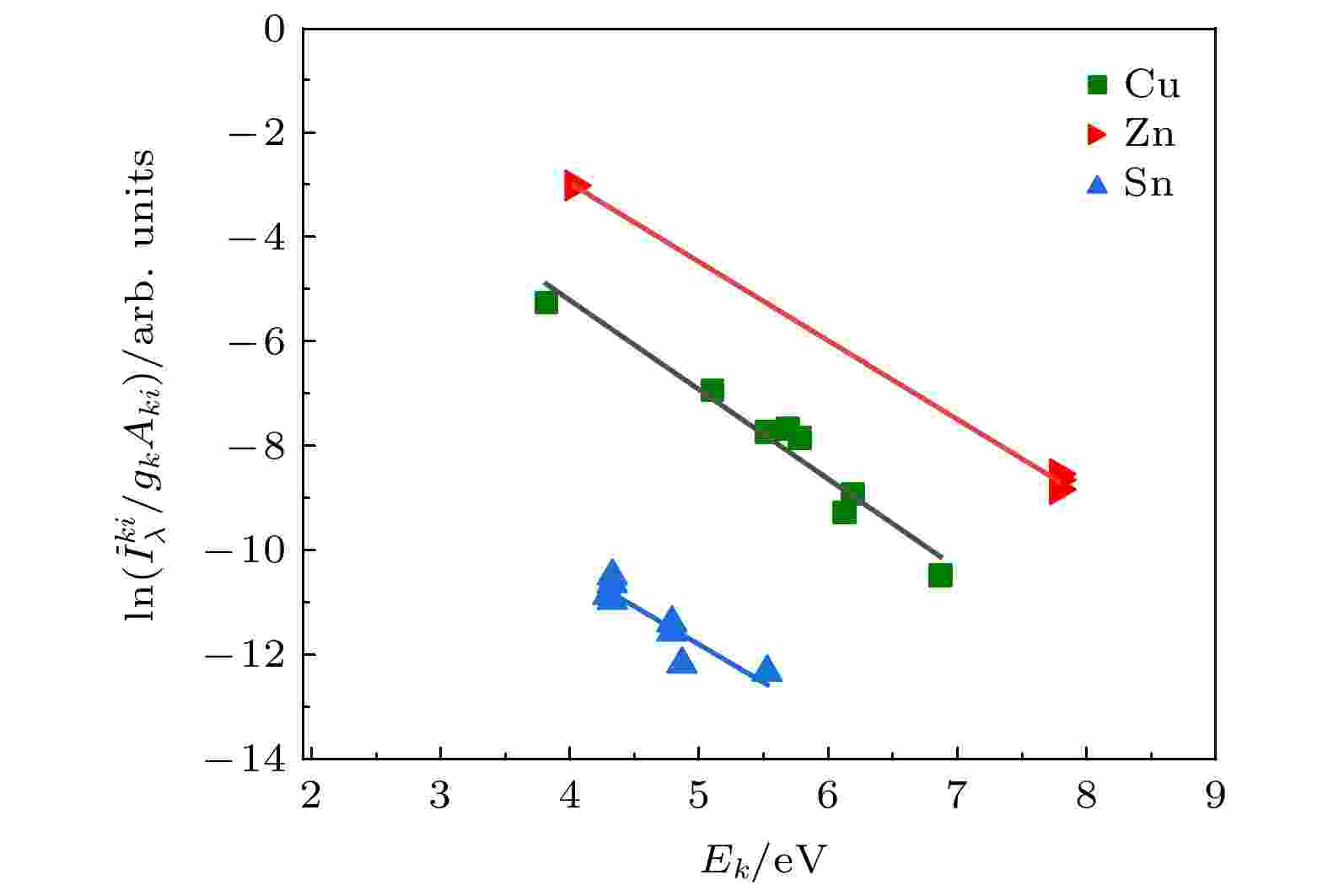 图 3 用于测定等离子体温度的玻尔兹曼图
图 3 用于测定等离子体温度的玻尔兹曼图
















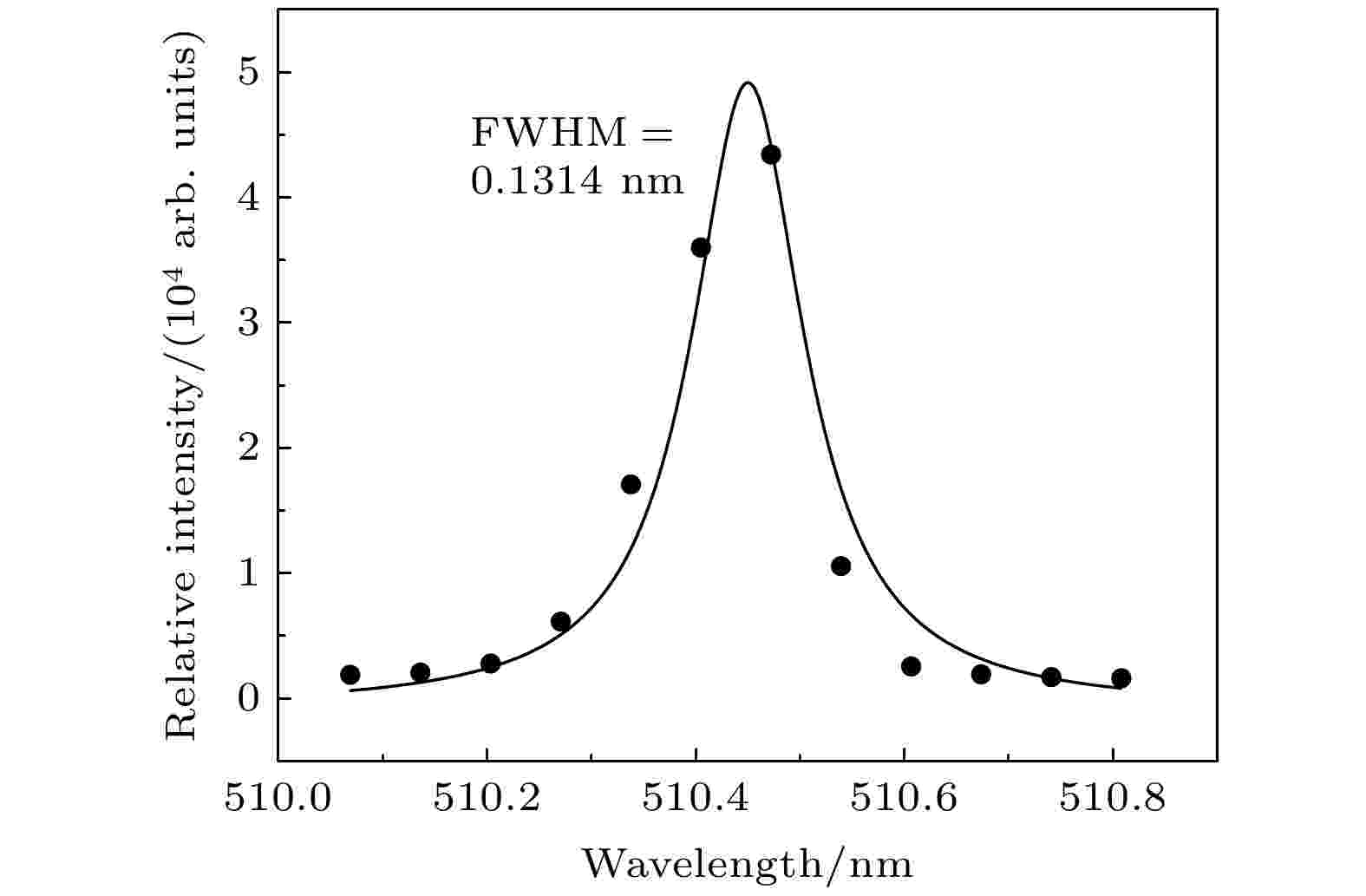 图 4 Cu I 510.47 nm谱线的洛伦兹拟合图
图 4 Cu I 510.47 nm谱线的洛伦兹拟合图



















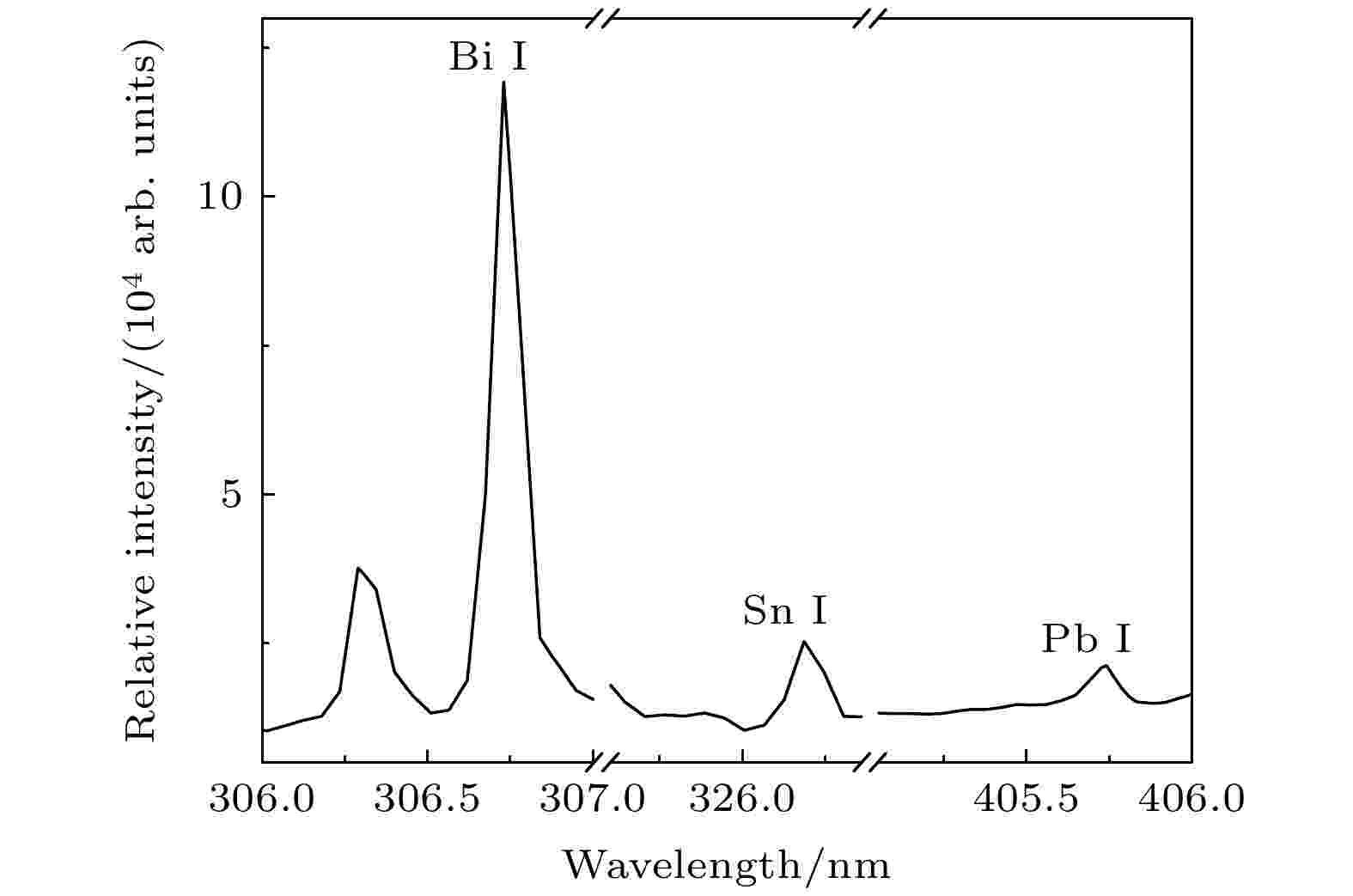 图 5 校准后的2号样品的局部光谱图
图 5 校准后的2号样品的局部光谱图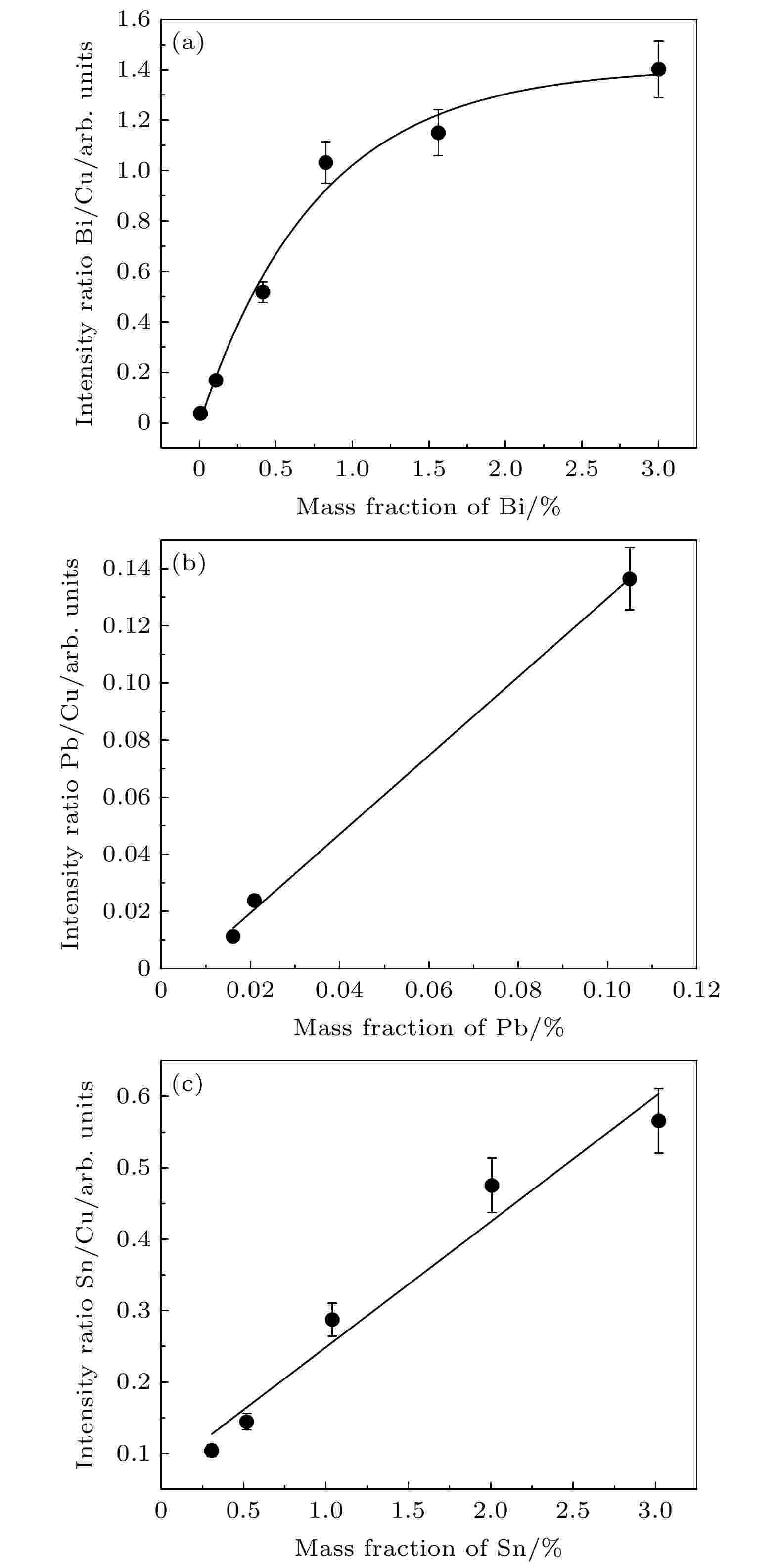 图 6 用HRR LA-SIBS分析铋黄铜中铋、铅和锡的校正曲线 (a) Bi; (b) Pb; (c) Sn
图 6 用HRR LA-SIBS分析铋黄铜中铋、铅和锡的校正曲线 (a) Bi; (b) Pb; (c) Sn



